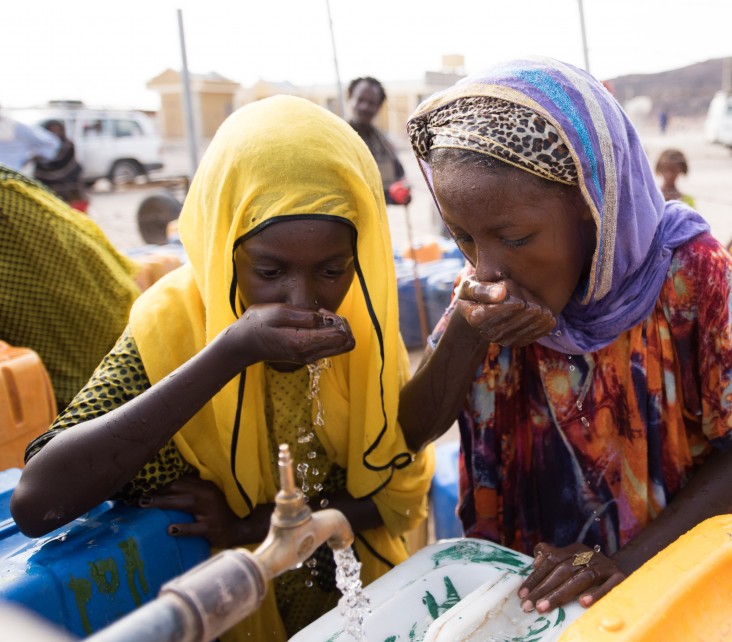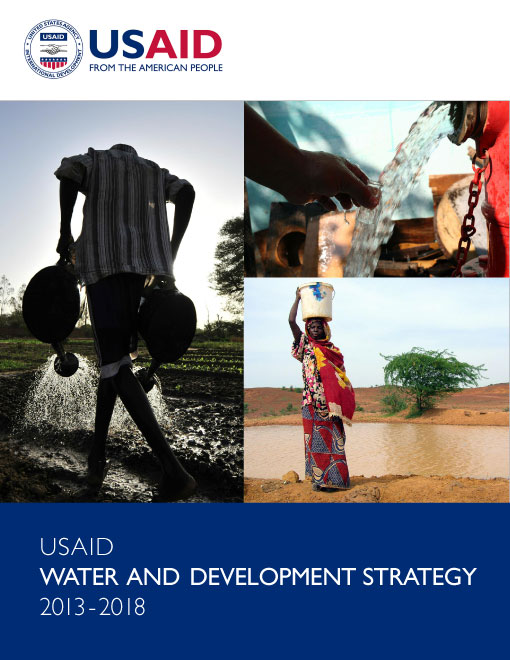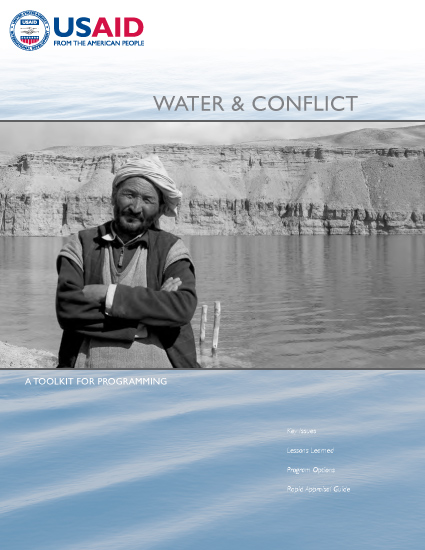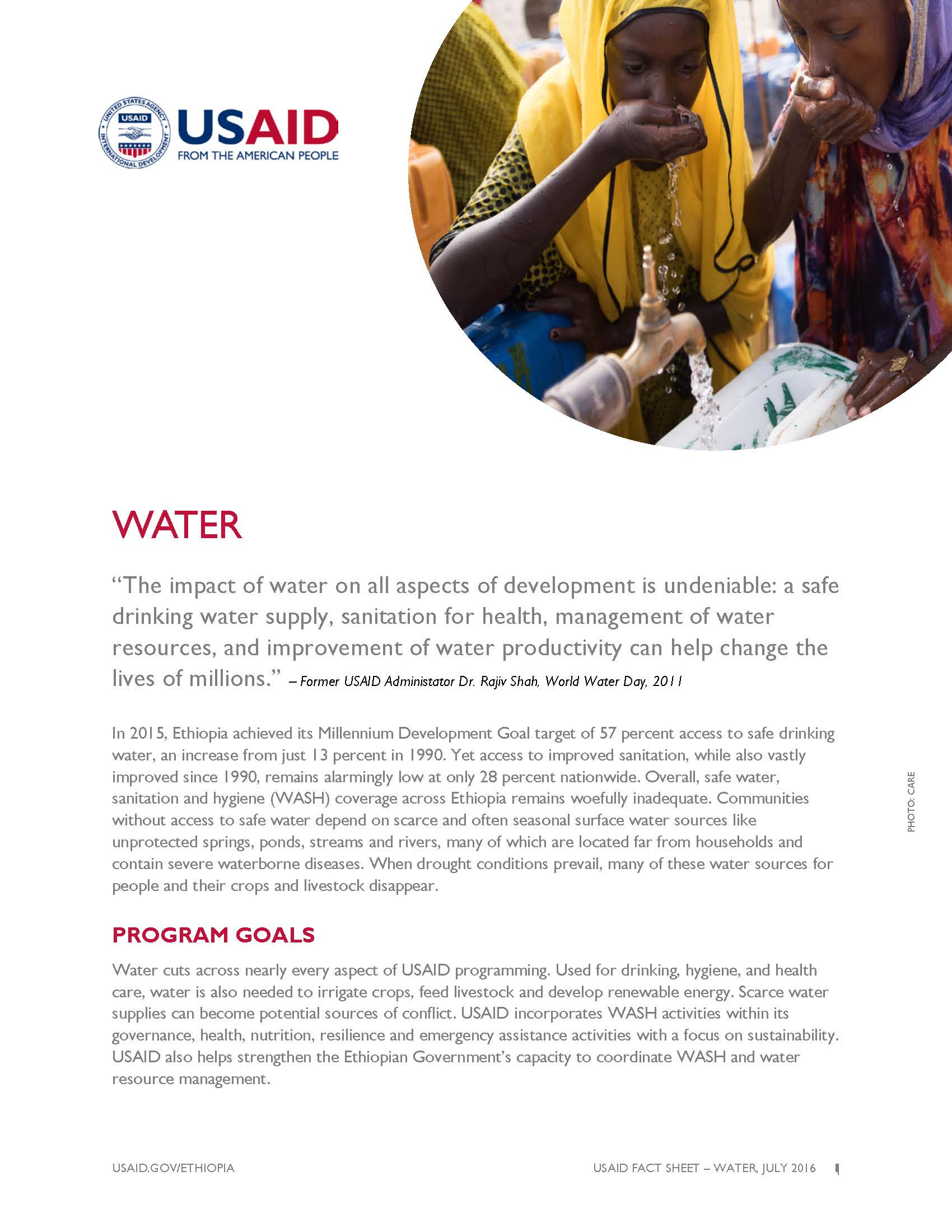
USAID Water and Development Strategy, 2013-2018 ![]() (pdf - 2 MB)
(pdf - 2 MB)
Ethiopia achieved its Millennium Development Goal target of 57 percent access to safe drinking water, halving the number of people without access to safe water since 1990. Yet access to improved sanitation remains stubbornly low at only 28 percent nationwide up from three percent in 1990. Despite these strides, safe water, sanitation and hygiene (WASH) coverage remains insufficient. Inadequate access to safe water and sanitation services and poor hygiene practices negatively impact health and nutrition; diarrheal disease is one of the leading causes of under-five mortality in Ethiopia.
Agricultural activity is by far the largest consumer of water in Ethiopia. An estimated 93 percent of all water withdrawals in the country (surface water and groundwater) are for agricultural use, much higher than the global average of 70 percent. However, water withdrawn for agriculture represents only an estimated four percent of the overall country’s available renewable water resources. While Ethiopia has relatively abundant water resources, it is considered ‘water stressed’ due to rapid population growth over the last decade. Estimates of renewable annual groundwater per year range from 13.5 to 28 billion m³, of which only about 2.6 billion m³ are currently exploitable. Natural variability in rainfall patterns and distribution, punctuated by extreme climatic events, has thrust many regions of the country into conditions of extreme water scarcity, degraded water quality and chronic food insecurity. At the other extreme, flooding is a significant problem in some parts of Ethiopia. Compounding the unpredictable nature of the country’s rainfall is the shortage of existing water related infrastructure.
Water and Conflict Toolkit ![]() (pdf - 6 MB)
(pdf - 6 MB)
The Government of Ethiopia aims to increase access to safe water supply and basic sanitation in rural and urban areas and to invest more resources into water related infrastructure. For example, under the One WASH National Program, the Government of Ethiopia aims to increase access to safe water supply to 98 percent for rural areas and 100 percent for urban areas and to provide all Ethiopians with access to basic sanitation. We support the Government of Ethiopia’s efforts by incorporating water, sanitation and hygiene activities into its health, education, humanitarian assistance and democracy and governance programs, and water resources management into its agriculture and food security activities.
Activities Include
Access to Water
- USAID Lowland WASH: Increase the availability of improved sustainable drinking water sources, increase access to better sanitation products and services, catalyze enhanced sanitation and hygiene behaviors, and build capacity for enhanced knowledge and data management, while also expanding sustainable water use for agriculture.
Nutrition
-
Empowering New Generations to Improve Nutrition and Economic Opportunities: Use nutrition cooking demonstrations and other platforms to conduct community conversations on WASH, to promote hand washing, safe water and food storage preparation and handling and use of latrines, and to ensure that participants understand the relationship between nutrition, illness and WASH practices in the Somali Region.
-
Growth through Nutrition: Uses sustainable, comprehensive, and coordinated interventions to improve the nutritional status of women and young children. Focuses on strengthening nutrition programs and policy, health care services, community-oriented nutrition and livelihood care and practices, access to clean water, and a rigorous learning agenda.
Health
-
Integrated Family Health Program through Evidence to Action: Strengthen and promote increased use of high-impact family planning, maternal, newborn and child health practices, products and services. The activity provides an integrated package of family planning and reproductive health, maternal, newborn and child health interventions. Investments directly support the Health Sector Development Plan and the Health Extension Program with a focus on delivery of key services and products through a continuum of quality care from the health center to the health post and community level in rural, peri-urban and hard-to-reach parts of the country. The activity promotes hygiene and sanitation through health extension workers.
-
USAID Transform: WASH: Promote the development and the marketing of WASH products in areas where residents have irregular access to water and sanitary goods and services. The activity takes an innovative, market-led approach to creating effective, consumer-centric products and services which are suitable for the conditions in which they live. Consumers will use the products to improve health, thereby reducing mal-nutrition and ill-health, particularly among women and children. As an outgrowth of the initiative, we promote the development of robust supply chains which provide economic opportunities to women and youth.
Agriculture and Food Security
-
Productive Safety Net Program: Construct and rehabilitate potable water sources and sanitation facilities through public works activities, promote hygiene education, provide water-harvesting technologies to smallholder farmers, and promote watershed management activities.
Small Grants
-
Fluorosis Mitigation with Innovative Technologies: Use innovative technologies for fluorosis mitigation for safe water.
-
Improving Waste Management in Hawassa City: Improve waste management in Hawassa City.
Featured Articles
-
Bringing Safe Water to Ethiopia [Transforming Lives]
-
Ethiopians Gain Greater Access to Safe Water [Transforming Lives]
-
Breathing Life into Ethiopia's Parched Watersheds [Transforming Lives]
-
USAID Higher Education for Development Initiative Builds a New Cadre of Professionals for Ethiopia's Water Sector [Transforming Lives]
Related Resources
-
USAID WASH & Nutrition Water and Development Strategy [PDF, 359kb]
-
Water Development in Ethiopia’s Pastoral Areas, [PDF, 4 MB]
-
Ethiopia Water is Life [Video, 6:55]
Related News
-
Too Much Flouride is Bad for Teeth and Bones (April 14, 2016)
-
USAID Launches 500 Million Birr Activity on World Water Day to Boost Ethiopia's One Wash National Program (March 22, 2016)
-
USAID Water Activity Launches New Water Systems in Somali Region of Ethiopia (November 18, 2014)
-
Hawassa Residents Gain Greater Access to Safe and Affordable Water (March 25, 2014)
-
Desalination Plant Opens in Afdera (January 15, 2014)
-
Remarks by Nancy Lindborg: Drought Resilience and Sustainability: First General Assembly of the IGAD Regional Platform (February 23, 2013)
-
USAID Higher Education for Development Initiative Builds a New Cadre of Professionals for Ethiopia’s Water Sector (March 27, 2012)











Comment
Make a general inquiry or suggest an improvement.